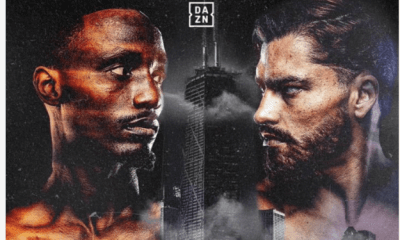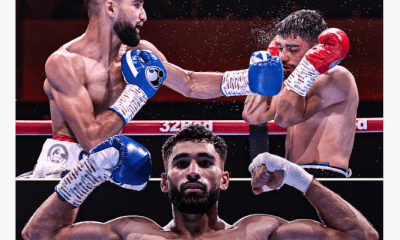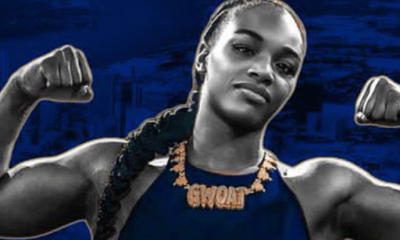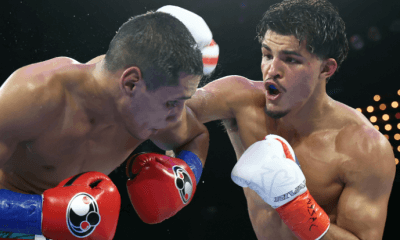Argentina
Part of Hagler’s Great Legacy Is Remaining at 160
Marvin Hagler was the undisputed middleweight champ from 1980 to 1987. It’s hard to fathom he just turned 64 (May 23rd), but from what I’ve seen
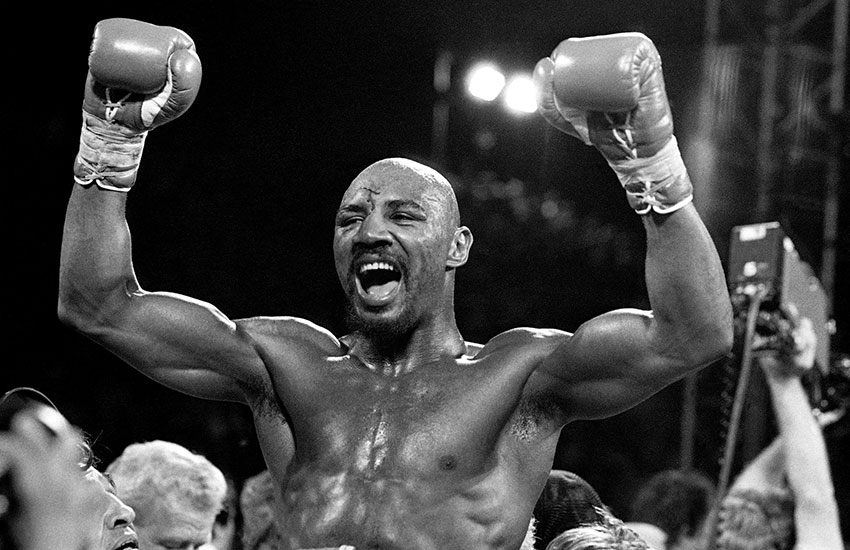
Marvin Hagler was the undisputed middleweight champ from 1980 to 1987. It’s hard to fathom he just turned 64 (May 23rd), but from what I’ve seen he still looks great. And like most all-time greats, the further away we get from his prime the more dominant he looks in hindsight. Hagler also has a huge fan base and his fans are very adamant about defending his legacy. And if ever there was a fighter who earned and deserves that type of support, it’s Hagler.
Most boxing fans know Marvin’s history. He was the 1973 National AAU middleweight champ and turned pro in May of that year. Early in his pro career he was avoided. Joe Frazier said to him, “you have three strikes against you, you’re black, you’re a southpaw and you’re good.” He was a ranked middleweight contender long before he finally got his first title shot in 1979.
To get a shot at name fighters Marvin had to fight in his opponent’s hometown, and ironically it was Frazier’s adopted city of Philadelphia where Hagler would suffer his first two losses. The first was to Bobby “Boogaloo” Watts in January of 1976 and the second was to Willie “The Worm” Monroe who was trained at one time by Frazier’s trainer Yancey Durham. Both fights were held at the Spectrum, the city’s largest indoor arena.
I attended both the Watts and Monroe bouts, and the loss to Watts was an outright hometown decision. However, Monroe beat Hagler legitimately and handled him at times during the fight. Hagler admitted after the fight that Monroe beat him and stated so in the Philly papers the next day.
Hagler avenged both losses by knockout and cleaned out an entire division of outstanding middleweights before getting his first title shot against Vito Antuofermo in November, 1979. The Antuofermo fight ended in a disputed draw and Vito, the defending champ, held the title. Ten months later Hagler took apart Alan Minter to capture the title. Minter won the title from Antuofermo and then beat him again in a rematch before losing it to Hagler. After beating Minter, Hagler made 12 consecutive title defenses with Roberto Duran and Thomas Hearns among his failed challengers. And then in his final defense, Hagler lost a 12-round split decision to Sugar Ray Leonard as a 4-1 favorite with only his WBC title on the line. Due to the bitterness he felt over the result, being totally convinced that he was robbed, Hagler never fought again.
Looking back it’s easy to glean that Marvin was special. In the ring, especially stylistically, Hagler was not the destruct and destroy killer he’s portrayed by many today. His shredded muscles and bald head projected he was an Earnie Shavers/Mike Tyson clone knockout specialist at 160, but he wasn’t. Marvin Hagler was a very good boxer-puncher with great foot work and balance. He had a great right jab and his money punch was his right hook. His left hand from his southpaw stance wasn’t close to special, but he used it to set up his right hook beautifully. He also never failed to let his hands go and his ring IQ processed things quickly; it didn’t take him long to figure out whom he needed to box and who he needed to go after.
The only time he miscalculated occurred during the first three or four rounds of his fight with Sugar Ray Leonard, and sadly that error in judgement cost him the decision. The fallacy regarding Hagler stylistically was that to beat him you had to back him up, but that was wrong. Marvin was at his best when his opponents brought the fight to him. He was more vulnerable fighting as the attacker as we saw in his bouts before he won the title and as the defending champ versus Duran and Leonard. The one outlier was the Hearns bout, in which he had no choice but to carry the fight and get inside on Hearns.
Hagler wasn’t a great puncher but he could punch, although he was mostly right hand reliant when fighting in his southpaw stance. His reputation as a puncher is based on one fight and that was the one with Hearns. Because it ended in three rounds it was assumed he was a puncher. The fallacy of that is that he hit Hearns cleanly more times flush in those eight minutes than he did most of his other title challengers their entire fight and with the exception of Caveman Lee and Mustafa Hamsho II, they all went beyond three rounds. Defensively, Hagler was solid. He could be caught between and during exchanges, but you couldn’t hurt him. And his condition was something to marvel at. The only time he even appeared to be breathing hard was during the later stages of his first bout with Antuofermo, a 15-round contest that was fast paced with a lot of give and take action.
There’s nothing to ding Marvin Hagler on as a fighter. He fought the best, never ducked anyone, always showed up in great shape and came to fight. And in 67 pro bouts (62-3-2) he was never really hurt, due to owning a cast iron chin, nor was he ever really beaten up by any opponent. It was some career!
Today, due to former middleweight champs Roy Jones and Bernard Hopkins moving up to challenge for and win the light heavyweight title, some excoriate Hagler for not doing the same. Instead he fought the likes of Duran, Hearns and Leonard who moved up in weight to challenge him at his best weight.
Don’t count me among that group admonishing him. Hagler was a natural middleweight and not a particularly big one at that. He wasn’t Jake LaMotta who often struggled to make the 160 limit. Hagler never sweated making weight. It wasn’t until Oscar De La Hoya entered boxing in 1992 as a junior lightweight and began compiling titles every five pounds that it became a big deal. Fighters move up in weight for one of three reasons….1) because they get lazy and are no longer disciplined enough to make weight…..2) they’ve legitimately outgrown their division….or 3) they’re chasing a big fight or view the bigger title holder as a favorable matchup. In Hagler’s case, the most money for him was to remain as middleweight champ and defy Duran, Hearns and Leonard to challenge him, something all three of them did in the years 1983-87.
Carlos Monzon, who Hagler is most often measured against, never moved up to challenge Bob Foster. And two of Monzon’s most high profile defenses were against former welterweight champ Emile Griffith and reigning welterweight champ Jose Napoles. Neither Monzon nor Hagler were capable of carrying 175 pounds effectively and the light heavyweight champ in both cases was a killer. For Monzon, Foster was certainly a bridge too far and Carlos knew it. And in Hagler’s case, there were two light heavyweight titlists, Michael Spinks, an all-time great, and Dwight Muhammad Qawi, a near-great, during his title reign.
There was never public clamor for Monzon to fight Foster or for Hagler to fight Spinks or Qawi. I trained and sparred with both Michael and Dwight during the years 1978-82. And circa 1980-82, when the talk of Hagler fighting Leonard and Hearns was big news, they both were frustrated and thought Hagler was being a bully. There was a time a little before the fight between Michael and Dwight grew into a super fight that Hagler represented big money for them, and both felt Hagler couldn’t tickle either of them. And looking back, they’re right. I remember both hounding boxing writers that came into the gym, asking to be quoted that they wanted some of Hagler and would even drop in weight to meet him. In Michael’s case, that was plausible, but Dwight, not so much. It wasn’t always a breeze for him to get down to light heavyweight.
Marvin Hagler was a true middleweight if there ever was one. There wasn’t a viable super middleweight division at the time for him to test like there would be for Jones and Hopkins. I respect that Hagler knew his limitations and crafted a true legacy as a middleweight great. I think that’s better than doing what De La Hoya, Mayweather, and Pacquiao did…winning a title up a few pounds against a beatable title holder only to do it again and again
Anyone who denigrates Hagler for not moving up to fight Spinks or Qawi for the light heavyweight title is wrong. Marvin created such a legacy as a middleweight that 30 years after his retirement, he’s still the fighter middleweight champs are measured against. And I seriously doubt Jones or Hopkins would have gone light heavyweight fishing if Spinks, circa 1981-85, or Qawi, circa 1981-83, awaited them.
Marvin Hagler is one of the top five middleweight champions in history. He didn’t need to fight the light heavyweight champ to justify his greatness. He achieved greatness the old fashioned way and never fought with a gimmick attached to any of his bouts!
Frank Lotierzo can be contacted at GlovedFist@Gmail.com
Check out more boxing news on video at The Boxing Channel
To comment on this article at The Fight Forum, CLICK HERE.
-

 Featured Articles3 weeks ago
Featured Articles3 weeks agoResults and Recaps from New York Where Taylor Edged Serrano Once Again
-

 Featured Articles5 days ago
Featured Articles5 days agoThe Hauser Report: Zayas-Garcia, Pacquiao, Usyk, and the NYSAC
-

 Featured Articles3 weeks ago
Featured Articles3 weeks agoResults and Recaps from NYC where Hamzah Sheeraz was Spectacular
-

 Featured Articles4 weeks ago
Featured Articles4 weeks agoFrom a Sympathetic Figure to a Pariah: The Travails of Julio Cesar Chavez Jr
-

 Featured Articles2 weeks ago
Featured Articles2 weeks agoManny Pacquiao and Mario Barrios Fight to a Draw; Fundora stops Tim Tszyu
-

 Featured Articles3 weeks ago
Featured Articles3 weeks agoPhiladelphia Welterweight Gil Turner, a Phenom, Now Rests in an Unmarked Grave
-

 Featured Articles2 weeks ago
Featured Articles2 weeks agoArne’s Almanac: Pacquiao-Barrios Redux
-

 Featured Articles4 weeks ago
Featured Articles4 weeks agoCatterall vs Eubank Ends Prematurely; Catterall Wins a Technical Decision


